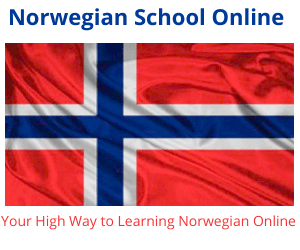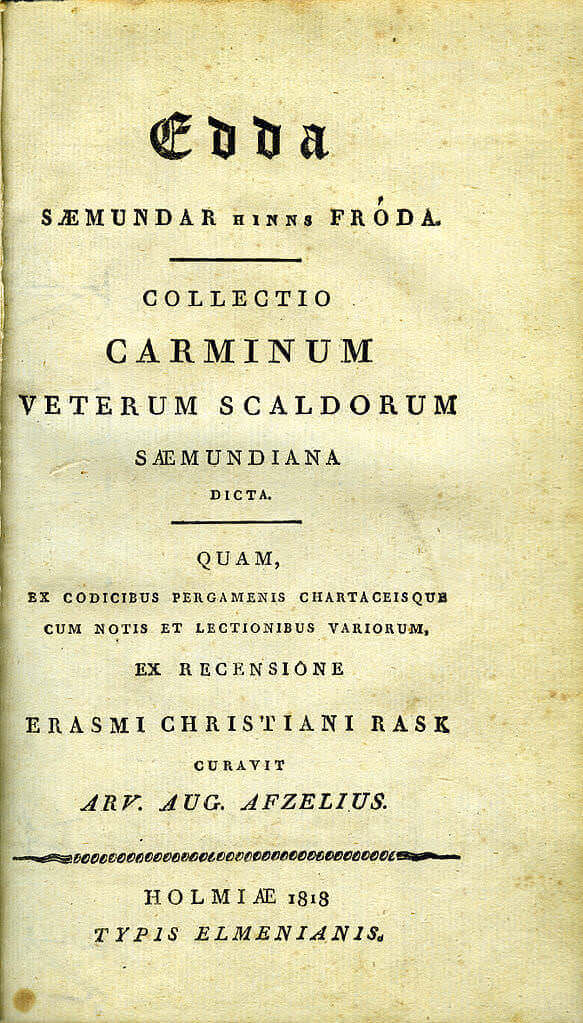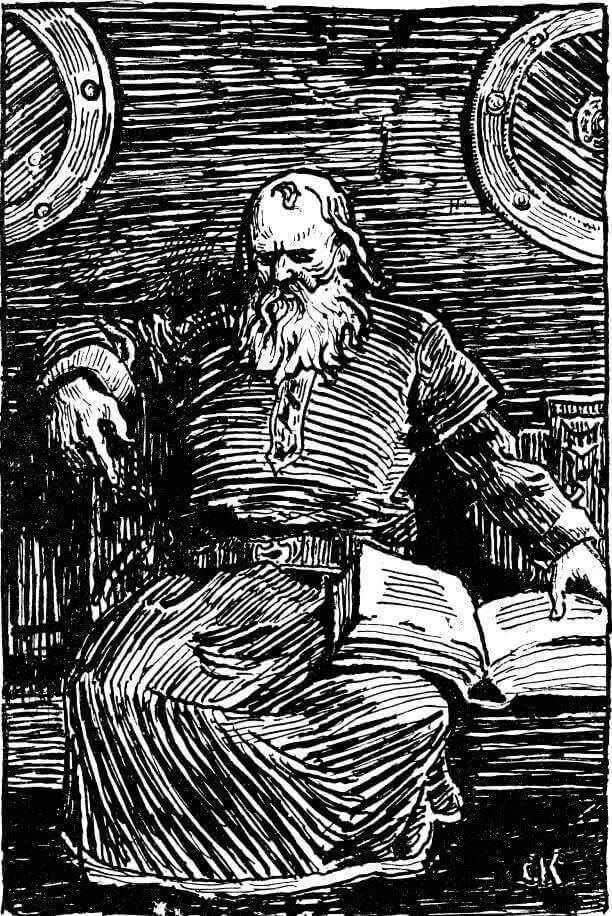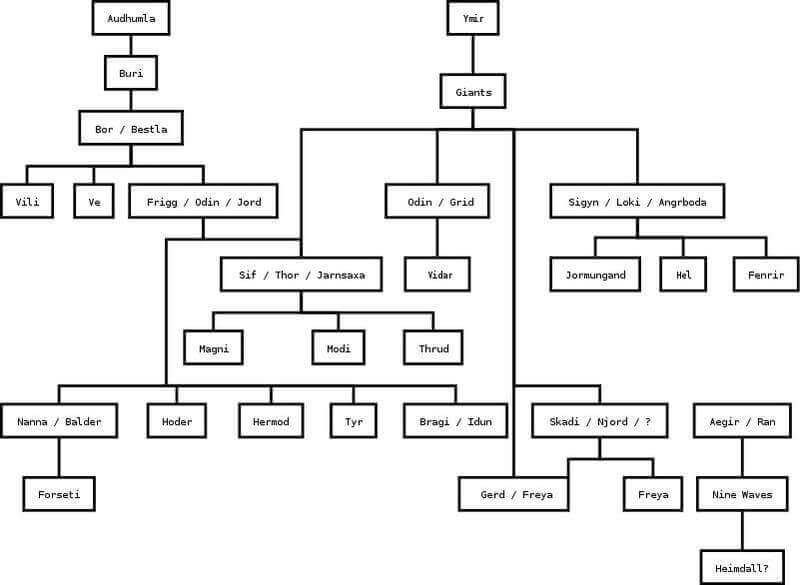With the immense contribution of Norse mythology to international history, there is a great deal of content to be found throughout the ages of literature in relation to this incredible source. Hundreds of well-recognized novels by famous authors have been based upon Old Norse Mythology and published throughout the centuries, including many critically famed authors through time from Chaucer to J.R.R. Tolkien and several others. Upon learning about Viking culture and tradition, along with Old Norse language, there is much inspiration to delve into Norse mythology to see its input toward contemporary literature, art, music and culture globally.
Chaucer’s novel House of Fame is similar to many mythological phenomena of the Old Norse stories. Figures like the frequently presented eagle and all of its activities, with the thorough imagery in the nature of birds and their surroundings, are presented within Chaucer’s novel and other similarities within several of his poems. Another famous author who has created at least one book based upon Norse mythology is J.R.R. Tolkien, not only The Lord of the Rings but also The Legend of Sigurd & Gudrún. This and other tales are based upon popular tales of Norse gods and giants, Sigurd and others, who would survive the final battle of the universe to build the arts and creation throughout the world continuing beyond the myths.
While Norwegian literature itself ranges back to the 9th century there is plenty to be scene of Old Norse Mythology as literature has grown internationally for centuries, building with historic and cultural events across the globe. Historically – 1290 anonymous publication titled The Saga of the Volsungs and the anonymous 1240 tale Egil’s Saga. The books Poetic Edda and Prose Edda were created in the Viking era, based upon 750-1100 with cultural sources of Germanic language. As the population spread to England and Scandinavia and Christianity took hold, the historic myths of Germanic culture remained strong through the Viking era. The anonymous Icelandic author of Poetic Edda at roughly 1270, along with the previous work of Icelandic poet Snorri Sturluson entitled Prose Edda which interprets traditional Icelandic poetry and laid out a tale of Gylfi, a Swedish king who visited the home of the gods to question their historic adventures and fate.
Old Norse history and language involves the incredible mythology that is invested not only in Norwegian culture, but globally into much of the literature and art we know today. From Scandinavia, Norse mythology was developed in Sweden, Norway, Denmark and Iceland, presenting a universe where the gods and giants battle among a cosmic conflict leading to the end of the world. Though the darkness of the winters and histories in these countries exists in the myths presented, a constant glimpse of grandeur and sparks of humor run through these myths that hold so much for the entire world. In addition to the incredible timeless artistic tradition provided by Norse mythology, there is much to be said for the Norse and Scandinavian literature and poetry that have displayed the national history and culture worldwide. Across the various Scandinavian nations much of these literary works date back to the 1200s with heroic sagas and poetry expanding the tales and strength of mythological gods and characters at the source of their nation.
There is a full set of Norse mythology tales that define out the beginning of the world, predicted through the end of life and creation with the description of what the final battle upon the earth will be.
One of the primary myths is that of the Aesir, gods of war and the sky. Odin was chief god of battle, wisdom and poetry, seen by the Vikings as ruler of the deities and creator of humans. The next in line is Thor, known as the warrior god of thunder, still very powerful to the mythological tales and world. Next there is Tyr, seen to be the sky god son of Odin, as well as another son Balder was known to be a gentle and beloved god who was murdered and expected only to return once a new world was created. The god, Loki, was known to be a cunning trickster who helped the other gods at times but cause trouble through his spiteful, destructive nature. Frigg, sky goddess, was Odin’s wife and the patron of marriage, households and children.
Another mythological tale of the Vanir relates this set of gods to the earth, fertility and prosperity. Initially at war against the Aesir, the tales of these two godly worlds may reflect a true historical conflict between two tribes, cultures or religions. Upon realization that neither side would win a battle, both groups of gods made peace and joined against a common enemy, the giants. Lasting peace was made in Asgard, home of the Aesir, where some of the Vanir became hostages. Some of the Vanir included Njord, patron of sea and seafaring, along with his twin children Freyr and Freyja, most important of the Vanir in representing love, sexuality and fertility. The giants were looking to capture Freyja, bringing the Aesir and Vanir together in battle against the giants.
Most of these mythological tales contain repetitive themes and myths including bravery in the midst of harsh fate that doomed the entire world of the gods and giants to eventual destruction. Reckless courage, honor and generosity existed in the many heroes of these mythological stories, representative of the complete evolution of the world throughout their existence, leaving the fame and recognition of these heroes as a form of life after death. In addition to the gods and giants, Norse mythology includes elves and dwarfs as well, creatures related to humans in various ways. The giants were powerful and feared, the huge beings associated with ice, snow and deadly cold, as they descended from Ymir, the frost giant killed by Odin and his godly brothers. Despite battles and vengeance, marriages often took place between the gods and giants, though rare human appearances take place in these myths. Evolving from Norse mythology, Norwegian literature contains heroic warriors, kings and ancestors including the Volsunga Saga from about 1300.
Norse mythology contains a tale of world and human creation, beginning with Ginnungagap which was a deep empty space between areas of heat and ice. Ymir was the initial frost-formed giant along with the appearance of Audhumla, a cosmic cow who revealed a man with three grandsons from licking off cliffs of ice. One of these grandsons was the god Odin who killed the frost giant Ymir along with both of his brothers and then formed the earth from his body, along with the seas and rivers from his blood and the sky from his skull. All of this was held together by the strength of four dwarfs to hold the sky above the earth and maintain structure. There is also the Voluspa which tells the tale of Odin and his brothers making the first man and woman from an ash tree and elm tree, giving humans life, intelligence and beauty. A quite different poem titled “The Lay of Vafthrudnir” states that the first man and woman grew from Ymir’s armpits before he was killed by the gods.
Among these various tales of Norse mythology develop the entire universe with the inclusion of Odin and other gods once they had killed Ymir and progressed to further creation. An orderly universe with three levels was created, with difficult and dangerous journeys between them. Asgard, home of the Aesir, was on the top, heavenly level along with Vanaheim home of the Vanir and Alfheim which is the home of the good elves. On the top level is also Valhalla, the hall where Odin gathered souls of warriors lost in battle. The rainbow bridge Bifrost leads the top level to the middle, earthly level of the universe. On this level are lands including Midgard of the men, Jotunheim of the giants, Svartalfaheim of the dark elves, and Nidavellir of the dwarfs. The bottom level of the universe was the underworld of Niflheim, referred to as Hel, the name of Loki’s daughter by whom it was ruled.
Running through all three levels of the universe was a great ash tree called Yggdrasill, linking all three worlds of heaven, earth and underworld together. The branches spread over the heavens and the tree’s roots spread into all three worlds. While springs rose from the roots of the tree, including the Well of Urd guardrd by the three goddesses of fate, the Norns. Animals brought into the universe include a serpent named Nidhogg who gnawed at the tree’s roots, an eagle perched atop the highest branch and there were also goats, deer and other creatures who ate the tree’s shoots and lived inside. A squirrel named Ratatosk ran up and down the trunk of the tree sending messages back and forth between the eagle and Nidhogg.
The tales ranging throughout Norse mythology continue from creation of the universe and man through to the predicted end of all the included beings. The tale of Ragnarok tells of the twilight of the gods and prediction that the end of the earth will begin with Loki’s trickery in killing Balder, the initial sign of the destruction of the universe. The gods chained Loki to a rock but he was eventually able to break free to lead the giants in a final battle against the gods and their greatest heroes from Valhalla. Upon the fall of Bifrost bridge Midgard will be cut off from Asgard leaving all monsters to run free. Upon the development of the battle, Fenrir kills Odin and Thor dies in fighting against the serpent Jormungard. Through all of this battle and danger among the universe, in the end the worlds will be consumed by fire and blood, leaving only one man and woman to survive under the shelter of the Yggdrasill tree of the universe and becoming the parents of a new human race.
The entire set of tales through Norse mythology maintain a valued legacy throughout centuries of literature and art around the globe. Through Voluspa, an image of an old woman able to predict the final days of the universe, great wars build around the world after three bitters winters and no interspersing summers, leaving fires of battle to destroy everything. Along with the initial man and woman of new creation, Balder and Thor’s sons will survive along with some of the minor gods. These survivors will sit on the green grass of the new world talking of battles and stories past, maintaining tales of the Norse mythological history throughout the development of the new world. Within the new world many of the inspired poems and sagas written during the Middle Ages came from the Norse mythology. Germanic hero Beowulf and several others were based upon Sigurd’s defeat of a monster with a special sword, maintaining the legacy of Norse mythology and the building of Norwegian and Scandinavian literature and poetry as well. Spreading into times closer to the present, more artists held onto these Norse myths and legends for inspiration, such as Richard Wagner using the legend of Sigurd within four German operas known as Der Ring des Nibelungen (The Ring of the Nibelung). The ability of Sigurd to understand the language of the birds upon roasting and eating the monster’s heart the magic of this tale is similar to many of the others upon which much of modern literary tradition was created.
Several modern authors have created various novels, fictional and fantasy, based directly and indirectly upon Norse mythology and the incredible stories within. One of the most famous is J.R.R. Tolkien and The Lord of the Rings including dragon slaying and enchanted rings, along with other authors and tales of elves and dwarfs in their work for the benefit of the human world. There was also the topic of Thor, one of the strongest and most spirited Norse gods, as the subject of the historically popular comic book series The Might Thor. Though the survival of the Norse gods was mythical, their presence throughout history has remained in literature and art, upholding the value of this creation of both the world and its culture.





Pingback:vioglichfu.7m.pl
Pingback:Cialis 20mg
Pingback:how to get cialis without doctor
Pingback:tadalafil without prescription
Pingback:example.org.17
Pingback:canada pharmacy online
Pingback:Viagra vs cialis vs levitra
Pingback:Viagra for sale
Pingback:Viagra prices
Pingback:Buy viagra
Pingback:buy cialis cheap
Pingback:buy tadalafil pills
Pingback:buy viagra pills online
Pingback:levitra generic 60 mg
Pingback:generic levitra online
Pingback:levitra 40 mg
Pingback:buy viagra no rx
Pingback:Viagra 5 mg
Pingback:Viagra generico
Pingback:levitra 20mg
Pingback:viagra without doctor prescription
Pingback:online viagra
Pingback:viagra 100mg
Pingback:viagra
Pingback:canadian pharmacies
Pingback:canadian pharmacies
Pingback:canadian pharmaceuticals online
Pingback:canada pharmaceuticals online
Pingback:pharmacy online
Pingback:cialis
Pingback:cheap cialis
Pingback:tadalafil generic
Pingback:cialis 20 mg
Pingback:international pharmacy
Pingback:pharmacie
Pingback:pharmacy online
Pingback:canada pharmaceuticals online
Pingback:we-b-tv.com
Pingback:tureckie_serialy_na_russkom_jazyke
Pingback:æóêè+2+ñåðèÿ
Pingback:Ñìîòðåòü âñå ñåðèè ïîäðÿä
Pingback:HD-720
Pingback:guardians+of+the+galaxy+2
Pingback:my id is gangnam beauty
Pingback:2020
Pingback:kpop+star+season+6+ep+9
Pingback:1 2 3 4 5 6 7 8 9 10
Pingback:movies
Pingback:movies online
Pingback:karan johar
Pingback:Top Movies
Pingback:Movies1
Pingback:11 10 2019
Pingback:smotretonline2015.ru
Pingback:Serial smotret
Pingback:kinokrad
Pingback:kinokrad 2020
Pingback:Watch TV Shows
Pingback:casino
Pingback:Kinokrad 2019 Kinokrad Hd
Pingback:serial 4
Pingback:serial
Pingback:youtube2019.ru
Pingback:trustedmdstorefy.com
Pingback:bofilm ñåðèàë
Pingback:bofilm
Pingback:Êîíñóëüòàöèÿ ïñèõîëîãà
Pingback:topedstoreusa.com
Pingback:hqcialismht.com
Pingback:viagramdtrustser.com
Pingback:где купить виагру
Pingback:гдз 9
Pingback:canadianpharmacystorm.com
Pingback:gencialiscoupon.com
Pingback:genericvgrmax.com
Pingback:гдз по геометрии 7 9
Pingback:гдз по алгебре 7 макарычев
Pingback:гдз 8 класс
Pingback:гдз мордкович 10 класс
Pingback:гдз атанасян 9
Pingback:гдз по русскому 10
Pingback:гдз по алгебре 11 класс
Pingback:гдз по русскому 6
Pingback:гдз 8
Pingback:гдз геометрия 10 11
Pingback:canpharmb3.com
Pingback:гдз по русскому 11
Pingback:гдз геометрия 11
Pingback:гдз класс по русскому
Pingback:гдз по английскому биболетова
Pingback:гдз 3 класс
Pingback:гдз миндюк
Pingback:гдз по геометрии 9
Pingback:гдз по алгебре 8 класс
Pingback:гдз 7 класс
Pingback:гдз по английскому языку 8
Pingback:viapwronline.com